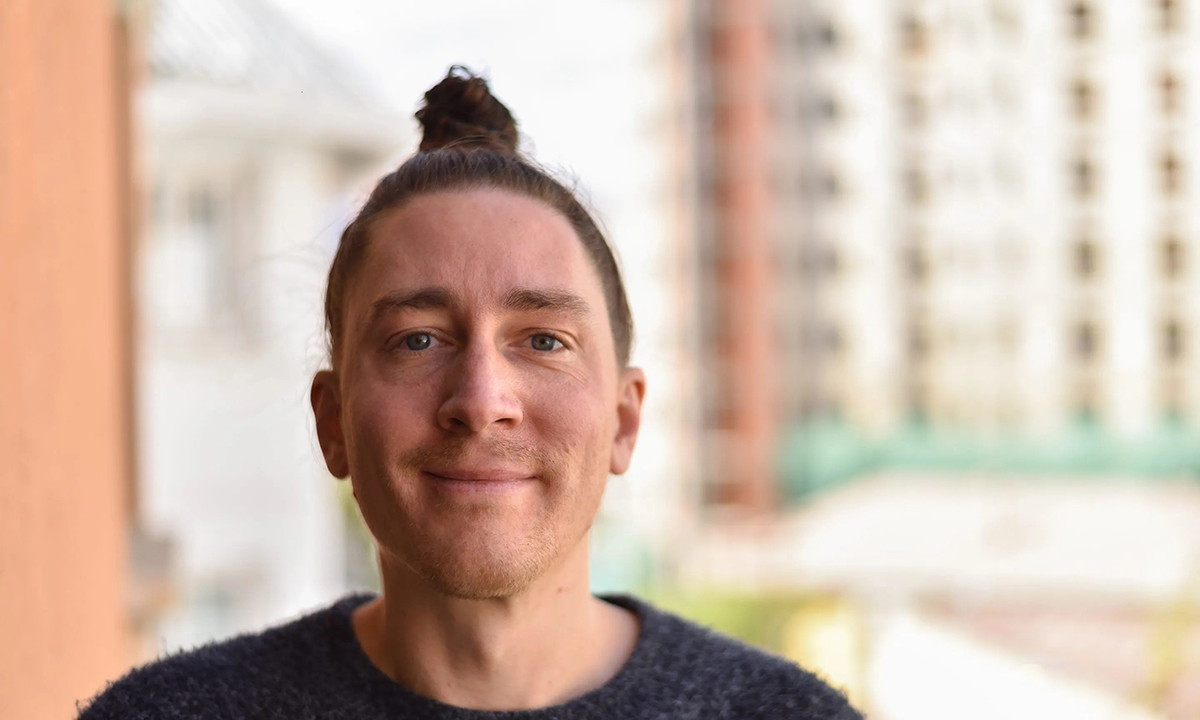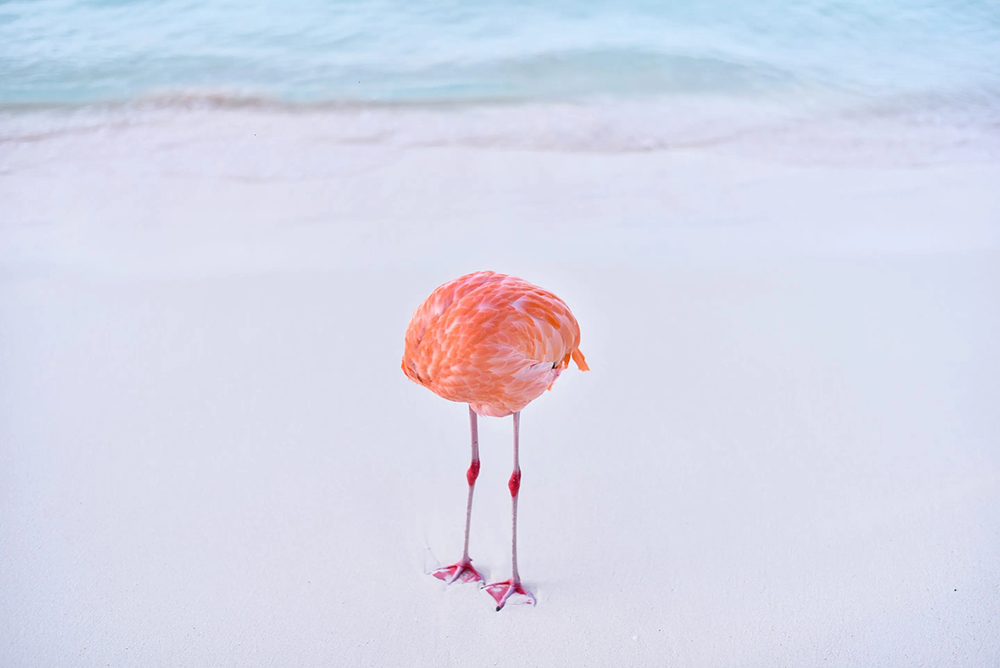
迈尔斯·阿斯特雷是一位跨学科艺术家,他将融合后的写作与摄影与艺术活动相结合。这一举动源于他于2012年开始的一场慢节奏沉浸式世界之旅。
作为一名作家和摄影师,人工智能生成内容的影响对我来说至少是两个层面的。不过,我倒是不那么担心这一颠覆性的技术可能对自身工作带来的影响。我已经构建了个人专属创意语言,这一点机器基本是不会的。我担心的是,结构性的社会变化可能会让生计、职业、工业以及民主基石在一夜之间消失。
别紧张,我并不是在预言世界末日,也不是在妖魔化人工智能。不过,我的确认为我们有必要尽快将公众有关人工智能的高谈阔论转化为实际行动。我们并非处于浪潮之上,而是深陷于深海之中,因此没有退路可言。
最近,我为自己的作品(下图)报名参加了1839摄影奖(1839 Awards),角逐人工智能组奖项。这是一个知名的国际摄影大赛。反常之处:这幅看似无头的火烈鸟是一张真实拍摄的照片,只不过这只鸟在忙着梳理腹部的羽毛罢了,因此颈部被腹部遮住了。我觉得,如果这幅报名作品能够俘获赛事知名评审委员会的芳心,那么我便能证明:人类制作的内容并没有失去其相关性;大自然及其人类解读者依然可以打败机器;以及创意和情感并非一串数字那么简单。

经过评审委员会评审,我的照片与少数几张“真正”的人工智能生成图片最终入围,并角逐两个奖项:评审选择奖以及公众投票奖。最终,这幅作品说服了评委和观众,于上周同时赢得了这两个奖项。据我所知,这幅照片是第一张赢得人工智能大奖的真实照片。
即便如此,那又能怎样?
什么是真,什么是非真?
当然,我对于误导评委感到不安,但我觉得他们是专业人士,他们也应该会意识到,此次对人工智能的发难及其道德层面的影响超过了欺骗观众这一不道德行为。当然,具有讽刺意味的是,人工智能其实也在欺骗观众。因此,这也是我最初决定采取这个不光彩手段的原因:近些年来,多张人工智能生成的照片在它们本不应该参赛的国际摄影大赛中夺得桂冠,成为了国际讨论热点。这一事实也凸显了该技术能力的不断增长。
在关注这些热点之余,我意识到我可以反其道而行之,做一件只有人类才可以做的事情。有人可能会说,人工智能给我带来了灵感,但很快就会有人回应说,这些机器依然是人类在操控,将人工智能当做是其视觉心腹。事实在于,这一理念确实说服了一批行业专业人士,包括《纽约时报》(New York Times)、费顿出版社(Phaidon Press)、华盖创意(Getty Images)、巴黎蓬皮杜艺术中心(Centre Pompidou)、佳士得(Christie’s)和马多克斯画廊(Maddox Gallery)的成员。这个事实也说明了一些问题,我觉得应该按照以下顺序排列:
• 自然依然超越机器。
• 我们的大脑还没有适应新常态。
• 人们已经无法分辨人工智能图片与真实照片。
第一个是毋庸置疑的。我现在来解释剩下的两个。
我认为这件事不应该责怪评审。事实上,他们并没有拆穿我的小伎俩并不是说他们专业不强,而是在于认知偏差。他们并没有想到有人会用真实照片报名参加人工智能组别比赛,因此没有做任何准备。谁又能想到此事?
然而,问题就出在这里:同样,我们作为一个社会,也压根没有准备去质疑我们遇到的每一个图片、音频文件或视频,因为在历史上我们无需这样做,亦或我们不应该这样做。可能是因为质疑眼前所有错误的事情和任何人,是一件可悲的事情。然而,如果我们希望走在AI前面,那么我们的批判性思考就必须与AI的光速发展进行角逐,这是我们每个人都应该承担的责任。
至于那些与现实没有多大区别的人工智能照片,我这么做背后的用意与柏林艺术家鲍里斯•艾尔达格森去年参赛的照片没有太大的区别,当时,他用一张人工智能生成的图片赢得了索尼全球摄影大赛的创意组奖项,只不过他是反其道而行之,相当于换汤不换药。人们目前还没有为应对人工智能的各种影响做好准备。
诚然,如果人工智能能得到合理的利用,它甚至有助于创意的提升。它确实在帮助艾尔达格森进行创作。然而,人工智能也会让很多创意徒有其表,取决于创意人士如何运用,以及我们会为此推行什么样的制度框架。一些创意人士已经在利用人工智能来外包一些琐碎的任务,并释放相关资源,让自己抽身从事真正热爱的项目。其他创意人士可能已经失去了不少机会,因为在了解人工智能生成内容的雇主眼中,他们的作品看起来流于形式。
不过,这种夸张的、非黑即白的场景中存在着很多灰色空间。例如,如果初创企业资金紧张,不愿意聘请图形设计师,也可以使用人工智能来创作免费的公司标志。因此,这位图形设计师就因此而失去了一份工作。同一家初创企业可能还会用人工智能来生成其博客的通用图库,同样的内容如果由图库摄影师完成的话得花不少钱。不过,这位图库摄影师可能已经在使用AI,以更低的价格来制作其内容。这件事情十分复杂。一旦我们开始讨论那些欺骗观众的具体内容,无论是有意还是无意,情形就会变得更复杂。例如,AI可能永远无法取代的便是有新闻价值活动的真实照片。不过,AI可以制造假照片,来虚构电脑之外从未发生过的新闻。
人工智能是利大还是弊大?
科技本身没有好坏之分,天生就是如此。真正决定其好坏的是人类使用科技的方式。如果我们没有在广岛扔原子弹,而是利用其来改变靠近地球行星的轨迹,我们可能会将其称为神圣炸弹。在推动人类进步或毁灭人类方面,人工智能与其他科技没有任何区别。
然而,既然我们未能利用好其颠覆性的前任——社交媒体,那么面对新一轮的变革,我们应该先发制人。不过别误会,我喜欢变革。我的整个人生都处于变化之中。不过,变化需要适应。当社交媒体让互联网发生巨变之时,它最初是通过连接全球各地的民众,然后推动了阿拉伯之春这类革命。非常好!不过在不久之后,它便成为了散播虚假新闻的元凶,伤害了选举和民主。
人工智能有望让这一切看起来就像是孩子们的恶作剧,相当于把大规模误导武器放到了任何需要它的人的手中,而且无需任何背景调查。如果我们希望获得标记人工智能生成内容的能力,那么我们可能有必要为其贴上标签。这一重担应由政府和私营领域来肩负,而且其重要性不亚于民间以及个人在批判性思维以及质疑司空见惯事情方面所应肩负的责任。我们必须引导年轻人去开展这件事情。
反响与深意
人工智能正在重塑数字领域的格局,受此影响,有关人工智能对内容未来及其背后创作者影响的讨论也是愈发激烈,这些创作者包括艺术家、记者和图形设计师。由此看来,我的恶作剧算是触碰到了敏感点。全球各地的新闻媒体纷纷报道此事,而且好的老社交媒体对其进行了放大。铺天盖地的积极反馈令我应接不暇。这个做法及其背后的动机获得了大量支持,不过,最令我感到惊讶和自愧不如的莫过于赛事组织方对此事的反馈。
在我告知赛事举办方“火烈鸟”照片的真实情形之后,考虑到需要公平对待其他使用AI图片的参赛选手,他们取消了火烈鸟照片的参赛资格。联合创始人兼总监莉莉·费尔曼给我发了一封邮件,并评论说,她非常欣赏此举深刻的用意,也肯定了相关声明的重要性和及时性。
她写到:“我们希望,此举能让众多担心人工智能的摄影师增强这一方面的意识,并为他们带来希望。”
就我自己而言,我希望我的胜利能成为业界众多创意人士的胜利,也希望那些担心人工智能的人士能真正意识到这一点。人工智能技术将常伴我们左右,因此我希望人们能够以一种造福众人的方式来适应它,采用它。(财富中文网)
Fortune.com上评论文章中表达的观点仅代表作者个人观点,并不代表《财富》杂志的观点和立场。
译者:冯丰
审校:夏林
迈尔斯·阿斯特雷是一位跨学科艺术家,他将融合后的写作与摄影与艺术活动相结合。这一举动源于他于2012年开始的一场慢节奏沉浸式世界之旅。
作为一名作家和摄影师,人工智能生成内容的影响对我来说至少是两个层面的。不过,我倒是不那么担心这一颠覆性的技术可能对自身工作带来的影响。我已经构建了个人专属创意语言,这一点机器基本是不会的。我担心的是,结构性的社会变化可能会让生计、职业、工业以及民主基石在一夜之间消失。
别紧张,我并不是在预言世界末日,也不是在妖魔化人工智能。不过,我的确认为我们有必要尽快将公众有关人工智能的高谈阔论转化为实际行动。我们并非处于浪潮之上,而是深陷于深海之中,因此没有退路可言。
最近,我为自己的作品(下图)报名参加了1839摄影奖(1839 Awards),角逐人工智能组奖项。这是一个知名的国际摄影大赛。反常之处:这幅看似无头的火烈鸟是一张真实拍摄的照片,只不过这只鸟在忙着梳理腹部的羽毛罢了,因此颈部被腹部遮住了。我觉得,如果这幅报名作品能够俘获赛事知名评审委员会的芳心,那么我便能证明:人类制作的内容并没有失去其相关性;大自然及其人类解读者依然可以打败机器;以及创意和情感并非一串数字那么简单。
经过评审委员会评审,我的照片与少数几张“真正”的人工智能生成图片最终入围,并角逐两个奖项:评审选择奖以及公众投票奖。最终,这幅作品说服了评委和观众,于上周同时赢得了这两个奖项。据我所知,这幅照片是第一张赢得人工智能大奖的真实照片。
即便如此,那又能怎样?
什么是真,什么是非真?
当然,我对于误导评委感到不安,但我觉得他们是专业人士,他们也应该会意识到,此次对人工智能的发难及其道德层面的影响超过了欺骗观众这一不道德行为。当然,具有讽刺意味的是,人工智能其实也在欺骗观众。因此,这也是我最初决定采取这个不光彩手段的原因:近些年来,多张人工智能生成的照片在它们本不应该参赛的国际摄影大赛中夺得桂冠,成为了国际讨论热点。这一事实也凸显了该技术能力的不断增长。
在关注这些热点之余,我意识到我可以反其道而行之,做一件只有人类才可以做的事情。有人可能会说,人工智能给我带来了灵感,但很快就会有人回应说,这些机器依然是人类在操控,将人工智能当做是其视觉心腹。事实在于,这一理念确实说服了一批行业专业人士,包括《纽约时报》(New York Times)、费顿出版社(Phaidon Press)、华盖创意(Getty Images)、巴黎蓬皮杜艺术中心(Centre Pompidou)、佳士得(Christie’s)和马多克斯画廊(Maddox Gallery)的成员。这个事实也说明了一些问题,我觉得应该按照以下顺序排列:
• 自然依然超越机器。
• 我们的大脑还没有适应新常态。
• 人们已经无法分辨人工智能图片与真实照片。
第一个是毋庸置疑的。我现在来解释剩下的两个。
我认为这件事不应该责怪评审。事实上,他们并没有拆穿我的小伎俩并不是说他们专业不强,而是在于认知偏差。他们并没有想到有人会用真实照片报名参加人工智能组别比赛,因此没有做任何准备。谁又能想到此事?
然而,问题就出在这里:同样,我们作为一个社会,也压根没有准备去质疑我们遇到的每一个图片、音频文件或视频,因为在历史上我们无需这样做,亦或我们不应该这样做。可能是因为质疑眼前所有错误的事情和任何人,是一件可悲的事情。然而,如果我们希望走在AI前面,那么我们的批判性思考就必须与AI的光速发展进行角逐,这是我们每个人都应该承担的责任。
至于那些与现实没有多大区别的人工智能照片,我这么做背后的用意与柏林艺术家鲍里斯•艾尔达格森去年参赛的照片没有太大的区别,当时,他用一张人工智能生成的图片赢得了索尼全球摄影大赛的创意组奖项,只不过他是反其道而行之,相当于换汤不换药。人们目前还没有为应对人工智能的各种影响做好准备。
诚然,如果人工智能能得到合理的利用,它甚至有助于创意的提升。它确实在帮助艾尔达格森进行创作。然而,人工智能也会让很多创意徒有其表,取决于创意人士如何运用,以及我们会为此推行什么样的制度框架。一些创意人士已经在利用人工智能来外包一些琐碎的任务,并释放相关资源,让自己抽身从事真正热爱的项目。其他创意人士可能已经失去了不少机会,因为在了解人工智能生成内容的雇主眼中,他们的作品看起来流于形式。
不过,这种夸张的、非黑即白的场景中存在着很多灰色空间。例如,如果初创企业资金紧张,不愿意聘请图形设计师,也可以使用人工智能来创作免费的公司标志。因此,这位图形设计师就因此而失去了一份工作。同一家初创企业可能还会用人工智能来生成其博客的通用图库,同样的内容如果由图库摄影师完成的话得花不少钱。不过,这位图库摄影师可能已经在使用AI,以更低的价格来制作其内容。这件事情十分复杂。一旦我们开始讨论那些欺骗观众的具体内容,无论是有意还是无意,情形就会变得更复杂。例如,AI可能永远无法取代的便是有新闻价值活动的真实照片。不过,AI可以制造假照片,来虚构电脑之外从未发生过的新闻。
人工智能是利大还是弊大?
科技本身没有好坏之分,天生就是如此。真正决定其好坏的是人类使用科技的方式。如果我们没有在广岛扔原子弹,而是利用其来改变靠近地球行星的轨迹,我们可能会将其称为神圣炸弹。在推动人类进步或毁灭人类方面,人工智能与其他科技没有任何区别。
然而,既然我们未能利用好其颠覆性的前任——社交媒体,那么面对新一轮的变革,我们应该先发制人。不过别误会,我喜欢变革。我的整个人生都处于变化之中。不过,变化需要适应。当社交媒体让互联网发生巨变之时,它最初是通过连接全球各地的民众,然后推动了阿拉伯之春这类革命。非常好!不过在不久之后,它便成为了散播虚假新闻的元凶,伤害了选举和民主。
人工智能有望让这一切看起来就像是孩子们的恶作剧,相当于把大规模误导武器放到了任何需要它的人的手中,而且无需任何背景调查。如果我们希望获得标记人工智能生成内容的能力,那么我们可能有必要为其贴上标签。这一重担应由政府和私营领域来肩负,而且其重要性不亚于民间以及个人在批判性思维以及质疑司空见惯事情方面所应肩负的责任。我们必须引导年轻人去开展这件事情。
反响与深意
人工智能正在重塑数字领域的格局,受此影响,有关人工智能对内容未来及其背后创作者影响的讨论也是愈发激烈,这些创作者包括艺术家、记者和图形设计师。由此看来,我的恶作剧算是触碰到了敏感点。全球各地的新闻媒体纷纷报道此事,而且好的老社交媒体对其进行了放大。铺天盖地的积极反馈令我应接不暇。这个做法及其背后的动机获得了大量支持,不过,最令我感到惊讶和自愧不如的莫过于赛事组织方对此事的反馈。
在我告知赛事举办方“火烈鸟”照片的真实情形之后,考虑到需要公平对待其他使用AI图片的参赛选手,他们取消了火烈鸟照片的参赛资格。联合创始人兼总监莉莉·费尔曼给我发了一封邮件,并评论说,她非常欣赏此举深刻的用意,也肯定了相关声明的重要性和及时性。
她写到:“我们希望,此举能让众多担心人工智能的摄影师增强这一方面的意识,并为他们带来希望。”
就我自己而言,我希望我的胜利能成为业界众多创意人士的胜利,也希望那些担心人工智能的人士能真正意识到这一点。人工智能技术将常伴我们左右,因此我希望人们能够以一种造福众人的方式来适应它,采用它。(财富中文网)
Fortune.com上评论文章中表达的观点仅代表作者个人观点,并不代表《财富》杂志的观点和立场。
译者:冯丰
审校:夏林
Miles Astray is a multidisciplinary artist combining writing and photography into art activism, inspired by a slow and immersive journey around the world that started in 2012.
As a writer and photographer, the implications of AI-generated content are at least twofold for me. I’m not all that concerned about the impact this disruptive technology might have on my own work though. I have created my personal creative language that the machine simply does not speak. What I am worried about are tectonic societal shifts that could wipe out livelihoods, professions, industries, and democratic pillars overnight.
Don’t worry, I am not prophesizing The End and do not demonize artificial intelligence. But I do think that we need to take the AI debate from public discourse to action as soon as possible. We are not on the cusp of a tidal wave—we are deep-sea-deep in it, and there is no rowing back.
Recently, I entered my work Flamingone (below) into the AI category of 1839 Awards, a prestigious international photo competition. The twist: The picture of a seemingly headless flamingo is as real as the belly scratch the bird is busy with, neck tucked below the torso. I thought if I could win over the award’s high-profile jury with my entry, I would prove that human-made content has not lost its relevance, that Mother Nature and her human interpreters can still beat the machine, and that creativity and emotion are more than just a string of digits.
The jury shortlisted my photo alongside a handful of “real” AI-generated images, which put it in the running for two awards: the jury’s decision and a public vote. In the end, it convinced both the jury and the audience, last week winning the people’s choice award and finishing among the jury’s winners. The picture, as far as I know, is the first real photo to win an AI award.
Point made. Now what?
What’s real and what’s really not
Of course, I felt bad about leading the jury astray, but I thought of them as professionals who might find that this jab at AI and its ethical implications outweighs the ethical implications of deceiving the viewer—which, of course is ironic because that is what AI does. And that’s how this twisted plot started in the first place: In recent years, several AI-generated photos made international headlines by winning photo competitions in which they were not supposed to compete, highlighting the technology’s rapidly increasing capacities.
Somewhere between those headlines, it occurred to me that I could twist the story inside down and upside out the way only a human could and would. Someone might even say that AI gave me the idea, but then someone else should quickly reply that it was the humans behind those machines, using them like visual ventriloquists. The fact that it did convince a jury of industry professionals—including members of the New York Times, Phaidon Press, Getty Images, Centre Pompidou in Paris, Christie’s, and Maddox Gallery—is telling of a few things, and I hope in this very order:
• That nature still outdoes the machine.
• That our brains are not yet attuned to the new normal.
• That AI imagery has become indistinguishable from depictions of reality.
The first one should go without saying. Let me address the other two.
I think the jury is not to blame here. The fact that they didn’t pick up on my little stunt doesn’t speak to a lack of expertise, but to the existence of psychological biases. They were simply not prepared for anybody entering a real photo into the AI category because they didn’t expect it. Why would they?
But that’s the thing: In the same vein, we, as a society, are nowhere near prepared to question every image, audio file, or video we come across, because historically we didn’t have to. And maybe we shouldn’t. Maybe that would be sad, to question everything and everyone that is not right in front of our eyes. But our critical thinking will have to race AI’s lightspeed development if we want to stay ahead of it, and that’s an individual responsibility we all share.
As for AI content that is indiscernible from the real deal, the message behind my stunt is not that different from the one Berlin-based artist Boris Eldagsen sent last year, when he won the Sony World Photo Awards’ creative category with an AI-generated image. Just that he came in from the other end. Same page, different book. We’re not ready for all of AI’s implications.
Sure, if AI is applied the right way, it could even boost creatives. It does help Eldagsen with his work. But it could also make many of them superfluous, depending on how those creatives adapt and what institutional guardrails we decide to put in place. Some creatives already leverage AI to outsource menial tasks and free up resources for their passion projects. Others might already have lost a gig here or there because their work looked superfluous to an employer in light of AI-generated content.
A lot of nuance awaits between the sensationalized black-and-white scenarios. For instance, a cash-strapped startup reluctant to hire a graphic designer can use AI to get a free company logo. But that graphic designer just lost a gig. And maybe that same startup lets AI generate a generic stock image for its blog, which costs a stock photographer a paycheck. Then again, that stock photographer might have already switched to AI to produce their content much cheaper. It’s complex. The slope becomes slippery once we start talking about less generic content that deceives the viewer intentionally or unintentionally. Something AI will likely never be able to replace, for instance, are real photos of a newsworthy event. It can, however, produce fake photos to make up news that never happened outside a CPU.
Will AI do more good or harm?
Technology isn’t inherently good or bad. It isn’t inherently anything. The way humans apply it makes it one thing or another. If we hadn’t dropped the atomic bomb on Hiroshima and had used it instead to deter an asteroid approaching Earth, we might have called it something like the Holy Bomb. In its potential to advance humanity or wreak havoc, AI is no different from many other technologies.
But where we lagged behind with its disruptive predecessor social media, we should get ahead of the change this time around. Don’t get me wrong, I love change. My whole life is change. But change calls for adaptation. When social media turned the internet upside down, it started out by connecting people all over the world and facilitating revolutions like the Arab Spring. Great! But it wasn’t long before it became instrumental to spreading fake news that hurt elections and democracies.
AI has the potential to make all that look like a kid’s prank, putting a weapon of mass-misinformation into the hands of anyone who wants it—no background check required. If we want the ability to flag AI-generated content, we’ll probably need to tag it. The onus would be on governments and the private sector, and almost as important as the civil and individual responsibility of critical thinking and questioning the apparently obvious. We’ll have to educate young people to do this.
Reaction to my stunt and what it means
With AI-generated content remodeling the digital landscape while sparking ever-fiercer debates about its implications for the future of content and the creators behind it—including artists, journalists, and graphic designers—my shenanigan hit a nerve. News outlets all over the world picked up the story, and good old social media amplified it. The overwhelmingly positive reactions have, well, overwhelmed me. There has been tremendous support for the idea and the statement behind it, but none has surprised and humbled me more than the reaction I received from the award organizers themselves.
After I revealed the true nature of Flamingone to them—and after they disqualified the entry out of fairness to contestants with actual AI images—cofounder and director Lily Fierman reached out with an email and remarked that she appreciates the powerful message and that it was an important and timely statement.
“We hope this will bring awareness (and a message of hope) to many photographers worried about AI,” she wrote.
As for me, I hope that my win was also a win for the many creatives out there, or really for anyone worried about AI. This technology is here to stay, so I hope we can adapt in ways—and adopt it in ways—that are beneficial for all.
The opinions expressed in Fortune.com commentary pieces are solely the views of their authors and do not necessarily reflect the opinions and beliefs of Fortune.






